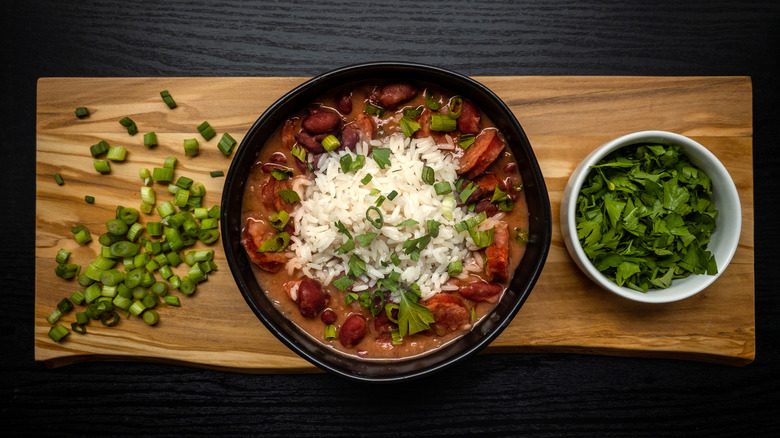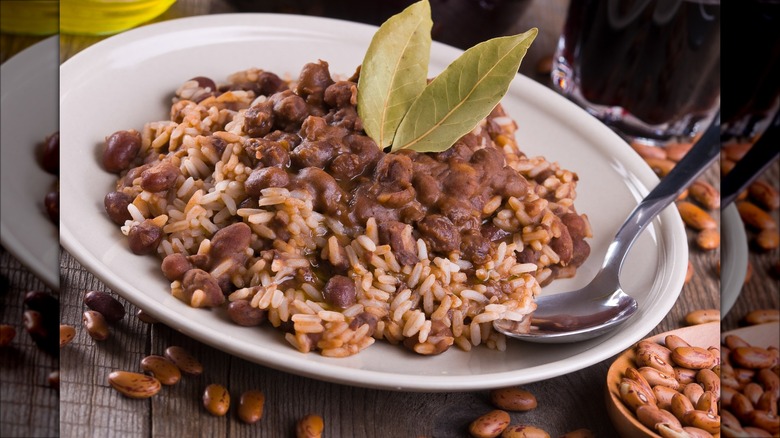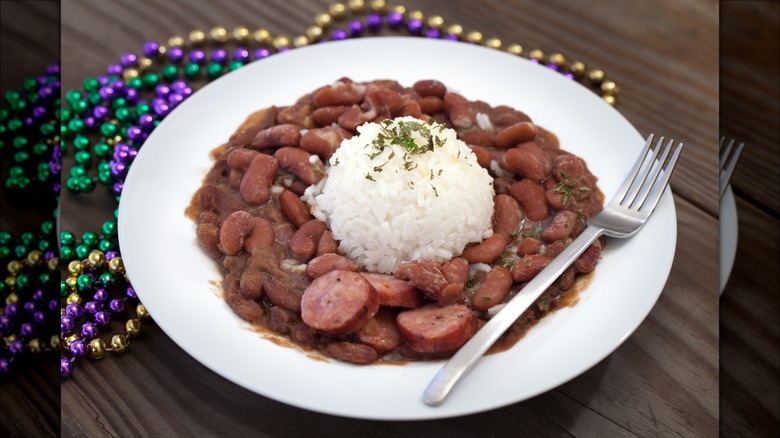How Red Beans And Rice Became A Symbol Of Mardi Gras And New Orleans Culture
There are plenty of famous New Orleans dishes that you should try when visiting the historic city. You can grab a po'boy or muffuletta for lunch and satisfy your sweet tooth with a beignet for dessert. One of those iconic dishes is a little more simplistic: red beans and rice.
Of course, the stew-like dish can be eaten any time, but in New Orleans, it's traditionally enjoyed on Monday nights. And while there's no definitive story behind the tradition, it is generally believed to have stemmed out of convenience. Before washing machines were available to clean clothes quickly, Creole women would have to wash the family's garments by hand, and for most households, Monday was laundry day. Since the task of doing all that laundry was incredibly time-consuming, they needed a quick and easy meal to cook, and many turned to red beans and rice.
Red beans and rice can simmer on the stovetop all day, making it an almost hands-off dish. It requires minimal stirring throughout the day, so the women could set it on the stovetop and leave it for a while while they did their laundry — like many people use slow cookers today.
Restaurants in New Orleans also get in on the tradition by serving up red beans and rice. Some places will even offer specials where diners can grab a complimentary plate of red beans and rice with any other purchase on a Monday.
Lundi Gras kicks off the festivities with red beans and rice
Even after the increased availability of the washing machine and the movement of women entering the workforce in larger numbers, red beans and rice remains a symbol of New Orleans culture, so much so that it is honored with Mardi Gras parades. The Monday before Mardi Gras (which always starts on a Tuesday) is called "Lundi Gras." Typically, two parades take place to honor — and coincide with — the tradition of eating red beans and rice.
The Red Beans Parade, run by the Krewe of Red Beans, marches through the streets with a parade float covered in dried beans, its participants wearing outfits decorated with and themed after the dish. It converges with another group, the Dead Beans Parade, which honors the afterlife and deceased loved ones similarly. A spinoff from the Red Beans Parade, the Dead Beans march with bean-themed floats and wear outfits decorated with dried beans, all with a skeletal twist.
How to upgrade the dish
There are a few ways to customize red beans and rice. If you enjoy some roast meat for dinner on Sunday night, don't throw out those leftovers! Though andouille sausage or ham hocks are traditional, you can easily bulk up the dish by tossing any meat you like in the pot along with the beans. You can also include any vegetables you like or need to use up; onions, celery, bell peppers, and tomatoes are common ingredients.
Another way to add flavor to your meal is to cook the rice in broth or stock rather than water. Alternatively, simply toss in bones from a previous dinner while the beans simmer to impart a little extra meaty flavor. And, of course, don't forget to season the pot. You can make your own Creole seasoning using a blend of ingredients like paprika, cayenne pepper, and garlic powder, or buy it premade from a brand like Tony Cachere.
Though the meal of red beans and rice may have humble origins, the dish has woven itself into an essential part of New Orleans culture over the years. The next time you visit the city — or catch yourself craving some Creole food — go ahead and grab a serving of the simple but delicious dish.


